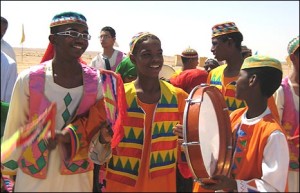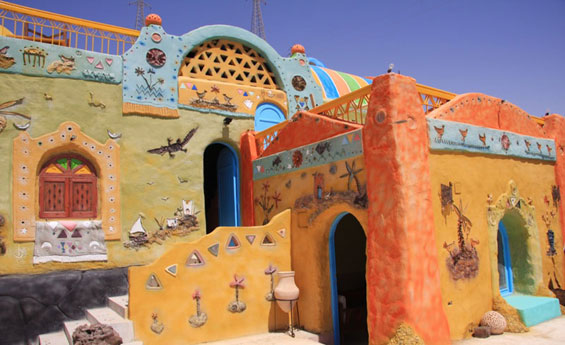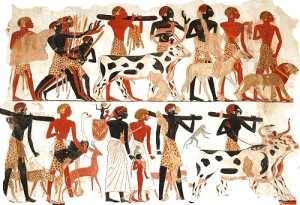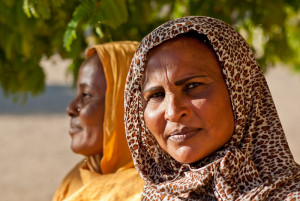By Amira Elhamy
From the moment you step in Ta-Seti, your eyes will blink faster when you see the unique colours of the city. Nature in Ta-Seti gives you a multiplicity and harmony of colors. The land, the greenery and the Nile comfort the eyes with its soothing tone. Florescent colors of the buildings and the clothes of the local people revive the eyes with its warm tones. This is in brief what will catch your eyes when you enter Ta-Seti or the land of Egyptian beauty, Nubia.
Ta-Seti, was the name that ancient Egyptians used to call, what is known nowadays as, Nubia. The ancient name means “the land of the bow”, where inhabitants were clever in manufacturing and using bows.
Nubia comes as an exceptional Egyptian spot that reflects uniqueness in every aspect of life, in its matchless architect, social norms, clothes, culture, nature and even history; its location is along the Nile river, in what is today known as, northern Sudan and southern Egypt. Nubia represents one of the earliest civilizations of ancient Northeastern Africa, with a history that can be traced from at least 2000 B.C. onward through Nubian monuments and artifacts, as well as, written records from Egypt and Rome. It was home to one of the African empires. There were a number of large Nubian kingdoms throughout the Postclassical Era, the last of which collapsed in 1504, when Nubia became divided between Egypt and the Sennar sultanate resulting in the Arabization of most of the Nubian population. Nubia was again united during the Ottoman rule of Egypt in the 19th century, and within the Kingdom of Egypt from 1899 to 1956.
Most information about ancient Nubia comes from archaeological excavations and from the study of monuments and rock art found there also, through the art and writing of Nubians. Records of ancient Egypt tell much about the history of Nubia, documenting a long and complex relationship between the two lands. Monuments and texts in the Egyptian language left by the Nubian kings, who became pharaohs of Egypt’s 25th Dynasty around 750 BC, also provide an extensive record.
Nubia has succeeded for many years to preserve its own culture and social norms. The uniqueness of Nubia is what makes it an exceptional spot in Egypt that never loses its taste. Visiting Nubia makes you see something different from what you see in everyday life. You live an experience.
Hoda, a Nubian female citizen in her mid-thirties who lived all her life in Nubia explains to The Middle East Observer (MEO) that living in Nubia is an exceptional experience. “We have been able to sustain our unique aspects of life for many years; we make our own food that you can taste only in Nubia. “Sanasel” is our most famous plate that we make out of baked dough and is cooked in special ovens then left to dry under the sun. It is served with the most famous Egyptian dish, “molokheya”, said Hoda.
Hoda, previously worked in the hotel business and confirms that life has changed over the last 50 years after the big migration of Nubians during Nasser ‘s era.
“Nowadays women have more contributions in different working fields. They work as doctors, nurses, engineers, teachers; it is not actually as most people think that Nubian women mostly stay at home. Moreover, we do not depend only on agriculture as before. Diverse working opportunities have been present within the Nubian market, especially within the tourism sector.”
As for the social norms, Hoda explains that a Nubian man would rarely marry a non-Nubian woman; the same applies for the Nubian woman, this is because Nubians are very eager to keep their norms and cultures intact. Social gatherings and celebrations represent one of the very important aspects of the Nubian community. 
“Weddings last for one week in Nubia. The groom and his relatives would pay visits to all the Nubians villages during this week to announce the marriage; they get invited over food in different Nubian houses even if the inhabitants of the village do not know him personally. His trip starts on Thursday and ends the following Thursday” explained Hoda.
The day that precedes the wedding, is called the “Henna Day”, the bride dresses in red, more or less like the Indian bride. Her female relatives wear their colourful dresses and wear over it a Nubian outfit called “Gergar”, which is a transparent black costume worn over female dresses. Nubians are fond of singing and dancing, says Hoda, during the wedding family and relatives sing Nubians lyrics over fast beat tempos that keeps the wedding alive all night long.
Nubians have their own dialect, historically they spoke at least two varieties of the Nubian language group, a subfamily which includes Nobiin (the descendant of Old Nubian), Kenuzi-Dongola, Midob and several related varieties in the northern part of the Nubia Mountains in South Kordofan. The Nubian languages are the indigenous languages of Nubia, along the Nile in southern Egypt and northern Sudan, and in fact the old Nubian language had its source in the languages of the Noba nomads who occupied the Nile between the First and Third Cataracts and the nomads who occupied the land between the Third and Fourth Cataracts.
Our dear readers, we hope you enjoyed your tour with us in the unforgotten land, hope you also enjoy other coming tours.# Stay Tuned#





